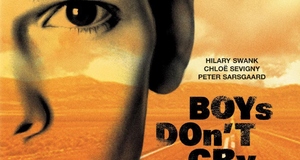Chalk Dreams: The Use of Fantasy as a Method of Rethinking Life in Ali Zaoua
By
2012, Vol. 4 No. 07 | pg. 2/2 | « The chalk animation depicts Kwita’s struggles to interact with someone outside of his class. The girl is wealthy and modern, while he cannot even afford to attend school. The figure is rowing the boat seemingly without any direction, and gets tired from his struggles to attain something he cannot even navigate to. Just like the sailor, Kwita works hard to survive, but can only do so much without something to guide him on his journey. He needs help, but neither society nor the mosque will help him. When the chalk sailor looks up in exasperation and the camera changes back to reality, it is as if he is acknowledging where Kwita is from (down the road to the port) as the reason why he cannot continue on his journey. He needs some kind of guidance or assistance to move beyond his situation – the compass that Ali left the boys, or a companion to help him navigate. In the next animated sequence, the scene continues and the film reveals what the sailor needs to continue with his journey. When we see the animated chalk sequence again, Kwita has been watching Boubker play soccer with other street boys (40:49). The camera cuts to the same billboard from the beginning of the film when Kwita said he was determined to bury Ali. We can assume that Kwita is looking at the billboard from the shot-reverse-shot sequence that Ayouch provides in this scene. In the boy’s perspective the billboard morphs from a real photograph of a woman into a chalk drawing of one. When the camera cuts back and forth between Kwita and the image, we see that the chalk woman smiles at him, making him smile back at the image. This is one of the only times in the film that we see this typically morose character smile. In the next frame the billboard loses its boundaries and becomes a sketch of a woman sitting on a bench that is floating in some body of water. When Boubker scores a goal, his yell calls Kwita back to reality, but the boy seems happier from having fantasized the experience through the modern apparatus. It is as if the dream gave him the opportunity to interact with a woman despite his inability to do so in real life. Ali’s dream of sailing to an island has thus inspired Kwita to come up with his own dreams of escape. The boy pulls out a photograph that he stole from the school girl and tells the other boy sitting with him that the girl in the picture is his sweetheart, and that she saw him on TV. Kwita then says that the two of them are going to get married and have a house. From the fantasy based on Ali’s dream, Kwita is able to reflect on his own life and what he would like – a female companion and a house in which he can live with her.The completion of the sequence from the last time he dreamed implies that the reason the sailor was unable to move forward was because he hadn’t yet met the girl that united traditional family values with modernity. Kwita’s dreams are somewhat materialistic and modern, and completely beyond his means, but they give him hope for his future and inspire him to do more with what he has. While he would like to make Ali’s funeral wonderful, he must also make his own life better through the unification of modern and traditional ideals. The animated drawings pick up where they left off the next Kwita sees his school girl crush. The progression of the film’s plot follows that of the dreams – the boy begins to try to communicate with the modern girl as the sailor meets and courts his own lady friend. In the ‘real’ scene, Kwita sees a flower-stand and then the camera cuts to him watching his imagined sweetheart leave her school. She walks over to talk to her friend by a chalk drawing of some sunflowers. We see and hear Kwita having an imagined conversation with her in which he has supposedly given her those flowers and she is responding happily. It can be assumed that Kwita drew the flowers for the girl after seeing the flower stand on the street. He cannot afford real flowers and the drawing is as close as he can get to giving her a present. As the “conversation” continues, the girl asks Kwita about his occupation and where he lives. “I don’t live off anyone’s back… and I’ll have an occupation, like Ali” (1:09:30). He then explains that Ali wanted to be a sailor and that he needs to find his own calling. He fantasizes that he has given her a necklace as well and says, “‘you still have my necklace?’ ‘Yes, I wear it at night, when I go out with my girlfriends” (1:09: 26-1:09:45). As the girl drives away, ending the imagined conversation, Kwita yells out of desperation. “I’ll bury him. Then I’ll come back!”(1:10:00). He’s made an excuse for his inability to talk to the girl, but in reality Kwita is separated from what he desires by his lack of money to court someone in the modern society. At night when the boys meet back up to discuss their progress in getting everything together for Ali’s funeral, Kwita talks to Omar and Boubker about what Ali is probably doing in heaven. They theorize that maybe he has a wife, since you can have anything you want in heaven (1:20:42). Omar says that when he goes to heaven, he’ll have lots of money and three cars. In the kids’ dreams, money and family are the central goals. Kwita even says Ali is probably hanging out on the ultimate sign of wealth – a yacht. The dreams --which blend traditional and modern values -- allow the boys the ability to temporary achieve both types of goals in their minds. In a world where street children have no money, no family, and no friends outside of each other, these dreams are creating temporary moments of happiness and hope for the future. However, in their dreams the only way to ever achieve a modern lifestyle is to follow traditional religious beliefs that would get them into heaven after death. The ideas about Ali’s life after death drift into a story about Ali on a boat in a storm (1:21:02). Even Omar participates in the temporary fantasy, saying that Ali dives under water with the rope between his teeth and pulls the boat forward. Ali is so idolized that in the dream he can move the boat without knowledge or money, but personal strength. He is beyond the restraints of the real world because of his own virtue. The camera once again uses shot-reverse-shot to cut back and forth between Kwita and what he is looking at --the sky. When it does so, the moon and stars develop into a chalk drawing from a normal still-frame image (1:22:34). A sailor made of chalk rows across the ocean-sky to his woman, who is waiting on the bench in the water as Kwita saw her earlier. She gets in the boat and they sail off together. The sailor’s dreams are achieved in the sky, just like the boys believe Ali’s are. The idea that everyone can achieve happiness – monetarily or romantically – after they die unites modernity and tradition within the dream to make Kwita smile again. He knows that as long as he remains faithful he will one day move beyond his means and actually get his dream life. Ali Zaoua concludes with one final chalk dream that actually consumes the three boys and takes them with the sailor and his wife to the imagined island (1:32:30). Kwita, Boubker, and Omar have finally found a way to give Ali his proper burial, and as they sail off into the sun with his body the film morphs back into the animated chalk drawing from the previous sequences. When the drawing becomes a close up of the boat, the sailor (at this point he looks like Ali) and his lady friend are on the boat and there is an island with two suns in the distance. The sailor finally has everything he needs to continue with his journey – a means of directing the boat and a woman to fulfill his ideas of a traditional family. The camera cuts from the vessel to an animation of the island itself with a house on it. The two people walk out of the house hand in hand, and the woman is pregnant. The sailor picks a flower and gives it to his wife, as Kwita imaged doing for his school-girl crush. The dreams of becoming “prince of the island,” being able to court a lady with gifts, and living in a house have been achieved symbolically for all of the children in the film. The animation ends as it becomes the actual drawing in the cave that Ali’s body was hidden in, then pans out of the hole in the ground (1:33:21). The film concludes by returning to Ali’s interview from the beginning. The street boys have finally united modernity and tradition, wealth and poverty to achieve their own dreams because they allowed themselves to follow the dream that Ali left behind when he died. In an interview Nabil Ayouch said that it was not the character of Ali that mattered, but what he represented to the other children in the film. “The goal was not to give him a physical embodiment, but to journey with the dream of this child, a dream which becomes that of his pals, of all children. It’s the mythical dimension of the character which interested me. As things play out, his status changes from that of a kid to that of a hero, then from a hero to a symbol. The film revolves around that” (Lowry). It is through this mythical dimension that the other children are able to look beyond their current situation as poor orphans to see what the world can offer them – whether modern or traditional in nature. The dreams create a bridge between the two sides of society depicted in Ali Zaoua: Prince of the Streets while providing moments of happiness and hope as the children struggle to deal with the effects of poverty in Casablanca.
ReferencesAbu Aisha, B. (n.d.). Funeral Rites and Regulations in Islam. Retrieved from http://www.missionislam.com/knowledge/funeral.htm Carter, S. G. (2009).What Moroccan cinema? : A historical and critical study, 1956-2006. Lanham, MD: Lexington Books. Emporis, (n.d), Casablanca Twin Towers. Retrieved from http://www.emporis.com/complex/casablanca-twin-towers-casablanca-morocco Lowry, S., & Dembrow, M. (2001, March 26). Interview with Nabil Ayouch. Retrieved from http://spot.pcc.edu/~mdembrow/alizaouainterview.htm Orlando, V.K. (2011) Screening Morocco: Contemporary film in a changing society. Athens, OH: Ohio University Press. Suggested Reading from Inquiries Journal
Inquiries Journal provides undergraduate and graduate students around the world a platform for the wide dissemination of academic work over a range of core disciplines. Representing the work of students from hundreds of institutions around the globe, Inquiries Journal's large database of academic articles is completely free. Learn more | Blog | Submit Latest in Film & Media |
















